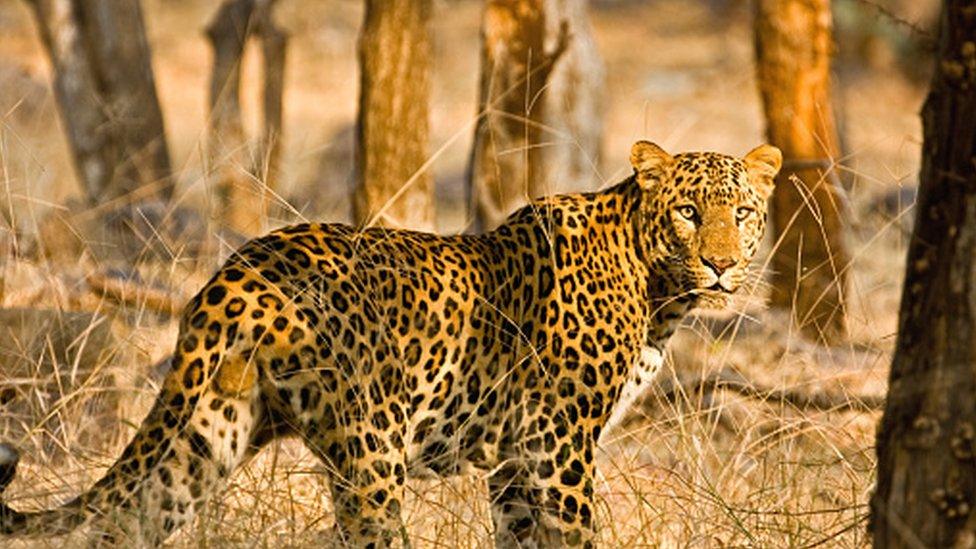Bijnor: Leopard attacks spark fear in Uttar Pradesh district
- Published

Leopards are shy creatures but can venture into human habitats for food
Manisha Singh cannot forget the day her six-year-old daughter, Yashi, was attacked by a leopard.
"I saw the animal come into our front yard, grab my daughter and run. That was the last time I saw her alive."
Ms Singh found her daughter several hours later in a sugarcane field near their house in Moosepur, a small village in Uttar Pradesh state's Bijnor district. Yashi was already dead by then.
The attack was just one of many in Bijnor. In the past three months, seven people have died due to leopard attacks in the district. Five of these attacks took place in the span of just eight days, between 19 and 26 April - and increased fear and panic across villages in the district.
Forest officials say that leopard attacks aren't uncommon in the area but that there has been a sudden rise in recent weeks.
"The attacks have also become extremely aggressive," says Mahesh Chand Gautam, a forest official. "But why that is happening now is yet to be ascertained."
"We need to find out the circumstances under which the human attacks took place. What time of the day, who the victims are, and what situations they were in at the time of the attack," says NVK Ashraf, chief veterinarian for the Wildlife Trust of India.

Yashi, 6, was killed by a leopard in April
Leopards are shy animals, but over the years, there have been several instances of them venturing into villages and cities in search of prey as their habitats shrink.
They are a common sight in Bijnor - a lush region which has a combination of grasslands, wetlands and dense forest, all of which offer natural habitat to the big cats, says Mr Ashraf.
"Leopards can live in a mosaic of forested areas and agricultural fields and are very adaptable," he adds.
It is difficult to estimate their numbers accurately in Bijnor, but forest officials say that the population has been rising steadily.
Mr Ashraf says expansive sugarcane crops in the area - spread across thousands of acres - provides sufficient cover for the animals to hide and hunt prey.
"This allows leopards to breed more, leading to a rise in their population," he says.
But experts also say that humans have encroached into spaces that the big cats have occupied for years, forcing the animal to stray into their settlements.
"The leopard considers the sugarcane fields as its habitat. So when people work on these crops, it creates a chance for an attack," Mr Gautam says.
Anish Andheria, president of the Wildlife Conservation Trust, says the attacks could be the result of the depleting habitat of the leopards.
"When large carnivores start living beside humans, their behaviour will then change over generations. They will think of humans as part and parcel of their ecosystems, considering them to be prey," he says.
It is rare for leopards to attack humans but Mr Ashraf says that there can be cases where the animal turns into a "man-eater" - not because it has tasted human blood, which is the popular but erroneous notion, but because humans are easier prey.
"The leopard may be incapable of hunting - either a damaged canine or an impaired claw, that may lead to it attacking what it considers is easier prey," he says.

Forest officials have placed cages in the area
People in Bijnor say that earlier, when they spotted the big cats in the fields, they would not feel scared. But the recent attacks have changed that.
Locals now avoid working alone in the fields, and many have asked their children not to step out of their homes.
"We always carry sticks with us to defend ourselves," says Faiyaz, a resident.
Officials have stepped up efforts to capture the animals, setting up several trap cages around the site of the attacks. "So far we have captured 10 leopards," says AK Singh, the forest official deputed of the district.
The leopards were released in the Amangarh forest reserve area, about 20km (12 miles) from the villages where the attacks took place.
Forest officials say that this exercise helped in bringing down attacks in the past.
They have also issued advised villagers to work in groups to lessen the chance of an attack. "We also asked them to avoid sitting in fields while working because the leopards might consider them prey," Mr Gautam says.
As efforts to capture the leopards continue, fear lingers in Bijnor.
In Moosepur village, Yashi's father Tekchand prepares to go to sell his produce at a nearby market.
"There is terror in the villages," he says. "I have to be back before sunset to ensure my family is safe."
BBC News India is now on YouTube. Click here, external to subscribe and watch our documentaries, explainers and features.

Read more India stories from the BBC:
